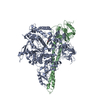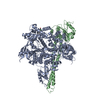[English] 日本語
 Yorodumi
Yorodumi- PDB-8w9a: CryoEM structure of human PI3K-alpha (P85/P110-H1047R) with QR-79... -
+ Open data
Open data
- Basic information
Basic information
| Entry | Database: PDB / ID: 8w9a | ||||||
|---|---|---|---|---|---|---|---|
| Title | CryoEM structure of human PI3K-alpha (P85/P110-H1047R) with QR-7909 binding at an allosteric site | ||||||
 Components Components |
| ||||||
 Keywords Keywords | ONCOPROTEIN / PI3K-alpha / lipid kinase / allosteric inhibition | ||||||
| Function / homology |  Function and homology information Function and homology informationperinuclear endoplasmic reticulum membrane / regulation of toll-like receptor 4 signaling pathway / response to muscle inactivity / phosphatidylinositol kinase activity / regulation of actin filament organization / negative regulation of actin filament depolymerization / response to L-leucine / positive regulation of focal adhesion disassembly / response to butyrate / 1-phosphatidylinositol-3-kinase regulator activity ...perinuclear endoplasmic reticulum membrane / regulation of toll-like receptor 4 signaling pathway / response to muscle inactivity / phosphatidylinositol kinase activity / regulation of actin filament organization / negative regulation of actin filament depolymerization / response to L-leucine / positive regulation of focal adhesion disassembly / response to butyrate / 1-phosphatidylinositol-3-kinase regulator activity / phosphatidylinositol 3-kinase regulator activity / IRS-mediated signalling / positive regulation of endoplasmic reticulum unfolded protein response / phosphatidylinositol 3-kinase activator activity / interleukin-18-mediated signaling pathway / T follicular helper cell differentiation / phosphatidylinositol 3-kinase complex / PI3K events in ERBB4 signaling / cellular response to hydrostatic pressure / phosphatidylinositol 3-kinase regulatory subunit binding / autosome genomic imprinting / myeloid leukocyte migration / regulation of cellular respiration / neurotrophin TRKA receptor binding / Activated NTRK2 signals through PI3K / cis-Golgi network / negative regulation of fibroblast apoptotic process / Activated NTRK3 signals through PI3K / transmembrane receptor protein tyrosine kinase adaptor activity / ErbB-3 class receptor binding / phosphatidylinositol 3-kinase complex, class IB / positive regulation of protein localization to membrane / vasculature development / 1-phosphatidylinositol-4-phosphate 3-kinase activity / Signaling by cytosolic FGFR1 fusion mutants / Co-stimulation by ICOS / RHOD GTPase cycle / cardiac muscle cell contraction / phosphatidylinositol 3-kinase complex, class IA / RHOF GTPase cycle / Nephrin family interactions / kinase activator activity / Signaling by LTK in cancer / anoikis / phosphatidylinositol-3-phosphate biosynthetic process / positive regulation of leukocyte migration / Signaling by LTK / MET activates PI3K/AKT signaling / relaxation of cardiac muscle / PI3K/AKT activation / 1-phosphatidylinositol-4,5-bisphosphate 3-kinase activity / negative regulation of stress fiber assembly / RND1 GTPase cycle / phosphatidylinositol-4,5-bisphosphate 3-kinase / positive regulation of filopodium assembly / RND2 GTPase cycle / RND3 GTPase cycle / vascular endothelial growth factor signaling pathway / phosphatidylinositol 3-kinase / growth hormone receptor signaling pathway / insulin binding / 1-phosphatidylinositol-3-kinase activity / Signaling by ALK / PI-3K cascade:FGFR3 / RHOV GTPase cycle / RHOB GTPase cycle / Erythropoietin activates Phosphoinositide-3-kinase (PI3K) / natural killer cell mediated cytotoxicity / GP1b-IX-V activation signalling / negative regulation of macroautophagy / PI-3K cascade:FGFR2 / response to dexamethasone / PI-3K cascade:FGFR4 / phosphatidylinositol-mediated signaling / PI-3K cascade:FGFR1 / RHOC GTPase cycle / RHOJ GTPase cycle / phosphatidylinositol phosphate biosynthetic process / intracellular glucose homeostasis / negative regulation of osteoclast differentiation / Synthesis of PIPs at the plasma membrane / RHOU GTPase cycle / RET signaling / CDC42 GTPase cycle / negative regulation of anoikis / PI3K events in ERBB2 signaling / Interleukin-3, Interleukin-5 and GM-CSF signaling / PI3K Cascade / insulin receptor substrate binding / intercalated disc / T cell differentiation / RHOG GTPase cycle / negative regulation of cell-matrix adhesion / extrinsic apoptotic signaling pathway via death domain receptors / regulation of multicellular organism growth / protein kinase activator activity / CD28 dependent PI3K/Akt signaling / RHOA GTPase cycle / Role of LAT2/NTAL/LAB on calcium mobilization / RAC2 GTPase cycle Similarity search - Function | ||||||
| Biological species |  Homo sapiens (human) Homo sapiens (human) | ||||||
| Method | ELECTRON MICROSCOPY / single particle reconstruction / cryo EM / Resolution: 2.7 Å | ||||||
 Authors Authors | Huang, X. / Ren, X. / Zhong, W. | ||||||
| Funding support | 1items
| ||||||
 Citation Citation |  Journal: Structure / Year: 2024 Journal: Structure / Year: 2024Title: Cryo-EM structures reveal two allosteric inhibition modes of PI3Kα involving a re-shaping of the activation loop. Authors: Xiuliang Huang / Kailiang Wang / Jing Han / Xiumei Chen / Zhenglin Wang / Tianlun Wu / Bo Yu / Feng Zhao / Xinjuan Wang / Huijuan Li / Zhi Xie / Xiaotian Zhu / Wenge Zhong / Xiaoming Ren /   Abstract: PI3Kα is a lipid kinase that phosphorylates PIP2 and generates PIP3. The hyperactive PI3Kα mutation, H1047R, accounts for about 14% of breast cancer, making it a highly attractive target for drug ...PI3Kα is a lipid kinase that phosphorylates PIP2 and generates PIP3. The hyperactive PI3Kα mutation, H1047R, accounts for about 14% of breast cancer, making it a highly attractive target for drug discovery. Here, we report the cryo-EM structures of PI3Kα bound to two different allosteric inhibitors QR-7909 and QR-8557 at a global resolution of 2.7 Å and 3.0 Å, respectively. The structures reveal two distinct binding pockets on the opposite sides of the activation loop. Structural and MD simulation analyses show that the allosteric binding of QR-7909 and QR-8557 inhibit PI3Kα hyper-activity by reducing the fluctuation and mobility of the activation loop. Our work provides a strong rational basis for a further optimization and development of highly selective drug candidates to treat PI3Kα-driven cancers. | ||||||
| History |
|
- Structure visualization
Structure visualization
| Structure viewer | Molecule:  Molmil Molmil Jmol/JSmol Jmol/JSmol |
|---|
- Downloads & links
Downloads & links
- Download
Download
| PDBx/mmCIF format |  8w9a.cif.gz 8w9a.cif.gz | 249.1 KB | Display |  PDBx/mmCIF format PDBx/mmCIF format |
|---|---|---|---|---|
| PDB format |  pdb8w9a.ent.gz pdb8w9a.ent.gz | 189.8 KB | Display |  PDB format PDB format |
| PDBx/mmJSON format |  8w9a.json.gz 8w9a.json.gz | Tree view |  PDBx/mmJSON format PDBx/mmJSON format | |
| Others |  Other downloads Other downloads |
-Validation report
| Summary document |  8w9a_validation.pdf.gz 8w9a_validation.pdf.gz | 1.3 MB | Display |  wwPDB validaton report wwPDB validaton report |
|---|---|---|---|---|
| Full document |  8w9a_full_validation.pdf.gz 8w9a_full_validation.pdf.gz | 1.3 MB | Display | |
| Data in XML |  8w9a_validation.xml.gz 8w9a_validation.xml.gz | 50.4 KB | Display | |
| Data in CIF |  8w9a_validation.cif.gz 8w9a_validation.cif.gz | 74.5 KB | Display | |
| Arichive directory |  https://data.pdbj.org/pub/pdb/validation_reports/w9/8w9a https://data.pdbj.org/pub/pdb/validation_reports/w9/8w9a ftp://data.pdbj.org/pub/pdb/validation_reports/w9/8w9a ftp://data.pdbj.org/pub/pdb/validation_reports/w9/8w9a | HTTPS FTP |
-Related structure data
| Related structure data |  37362MC  8w9bC M: map data used to model this data C: citing same article ( |
|---|---|
| Similar structure data | Similarity search - Function & homology  F&H Search F&H Search |
- Links
Links
- Assembly
Assembly
| Deposited unit | 
|
|---|---|
| 1 |
|
- Components
Components
| #1: Protein | Mass: 124230.750 Da / Num. of mol.: 1 Source method: isolated from a genetically manipulated source Source: (gene. exp.)  Homo sapiens (human) / Gene: PIK3CA / Production host: Homo sapiens (human) / Gene: PIK3CA / Production host:  Trichoplusia ni (cabbage looper) Trichoplusia ni (cabbage looper)References: UniProt: P42336, phosphatidylinositol 3-kinase, phosphatidylinositol-4,5-bisphosphate 3-kinase, non-specific serine/threonine protein kinase |
|---|---|
| #2: Protein | Mass: 83710.281 Da / Num. of mol.: 1 Source method: isolated from a genetically manipulated source Source: (gene. exp.)  Homo sapiens (human) / Gene: PIK3R1, GRB1 / Production host: Homo sapiens (human) / Gene: PIK3R1, GRB1 / Production host:  Trichoplusia ni (cabbage looper) / References: UniProt: P27986 Trichoplusia ni (cabbage looper) / References: UniProt: P27986 |
| #3: Chemical | ChemComp-UEX / Mass: 490.942 Da / Num. of mol.: 1 / Source method: obtained synthetically / Formula: C25H23ClN6O3 |
| #4: Water | ChemComp-HOH / |
| Has ligand of interest | Y |
-Experimental details
-Experiment
| Experiment | Method: ELECTRON MICROSCOPY |
|---|---|
| EM experiment | Aggregation state: PARTICLE / 3D reconstruction method: single particle reconstruction |
- Sample preparation
Sample preparation
| Component | Name: human PI3K-alpha (P85/P110-H1047R) with QR-7909 binding at an allosteric site Type: COMPLEX / Entity ID: #1-#2 / Source: MULTIPLE SOURCES |
|---|---|
| Source (natural) | Organism:  Homo sapiens (human) Homo sapiens (human) |
| Source (recombinant) | Organism:  Trichoplusia ni (cabbage looper) Trichoplusia ni (cabbage looper) |
| Buffer solution | pH: 8 |
| Specimen | Embedding applied: NO / Shadowing applied: NO / Staining applied: NO / Vitrification applied: YES |
| Specimen support | Grid material: GOLD / Grid mesh size: 300 divisions/in. / Grid type: Quantifoil R1.2/1.3 |
| Vitrification | Cryogen name: ETHANE |
- Electron microscopy imaging
Electron microscopy imaging
| Experimental equipment |  Model: Titan Krios / Image courtesy: FEI Company |
|---|---|
| Microscopy | Model: FEI TITAN KRIOS |
| Electron gun | Electron source:  FIELD EMISSION GUN / Accelerating voltage: 300 kV / Illumination mode: FLOOD BEAM FIELD EMISSION GUN / Accelerating voltage: 300 kV / Illumination mode: FLOOD BEAM |
| Electron lens | Mode: DIFFRACTION / Nominal defocus max: 1300 nm / Nominal defocus min: 900 nm |
| Image recording | Electron dose: 54.2 e/Å2 / Film or detector model: FEI FALCON IV (4k x 4k) |
- Processing
Processing
| EM software | Name: PHENIX / Version: 1.13_2998: / Category: model refinement |
|---|---|
| CTF correction | Type: NONE |
| 3D reconstruction | Resolution: 2.7 Å / Resolution method: FSC 0.143 CUT-OFF / Num. of particles: 420630 / Symmetry type: POINT |
 Movie
Movie Controller
Controller



 PDBj
PDBj



















